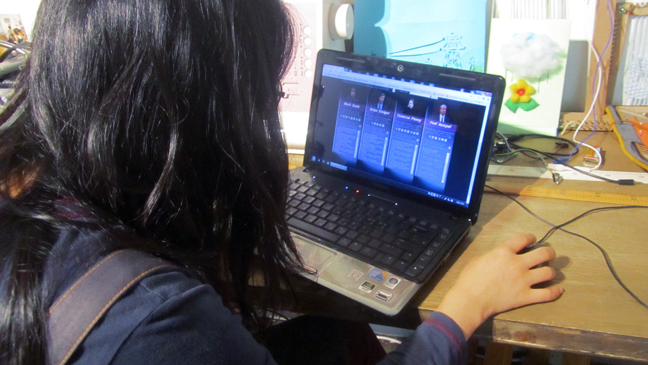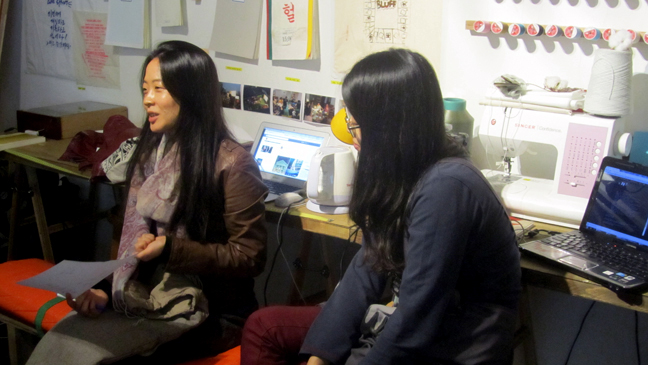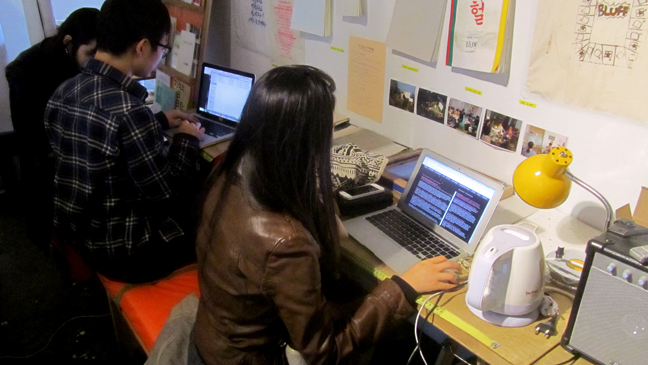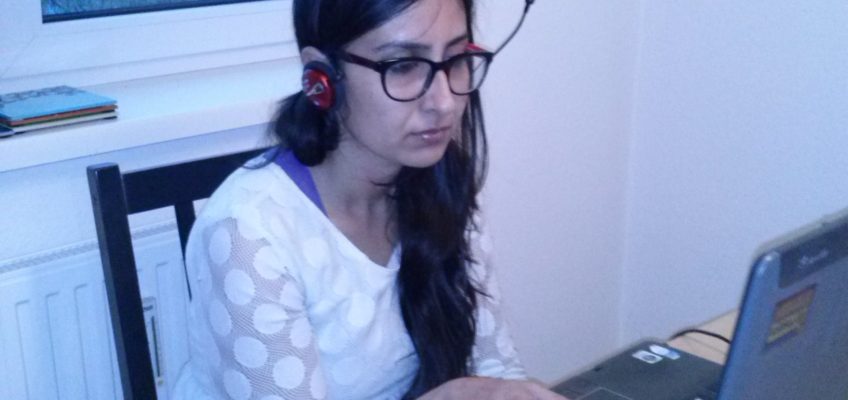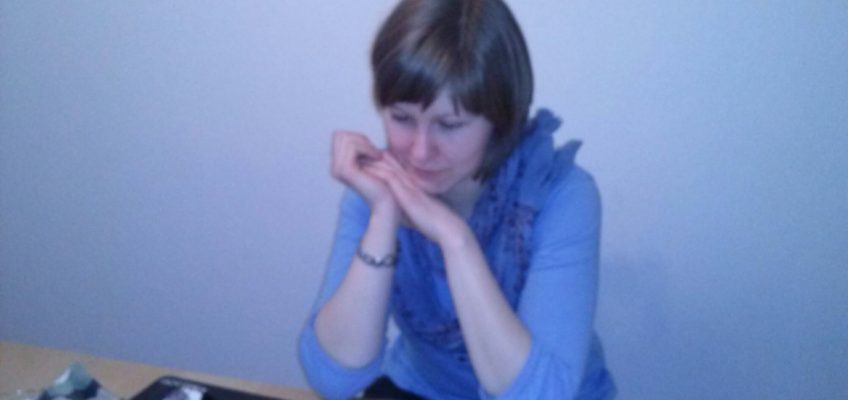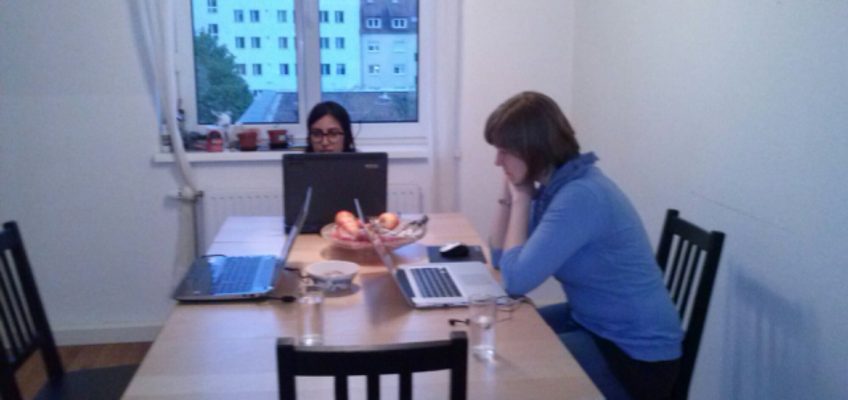Organized screadings:
26th of October 2pm-5pm part of Unmake Lab in Artist run space 413, Seoul, South Korea.
5th of May 2014, Linz, Austria
8th of April 2014, Linz, Austria
WORKSHOP: ‘SCREADINGS’ -READING AND ARCHIVING DIGITAL FICTION
This workshop offers the participants an introduction to digital fiction with an emphasis on artworks that are created and read in social media environments. Social media literature can be considered as a 4th generation of digital fiction and are thereby connected to a canon of hypertext, hypermedia and cybertext fiction. In the workshop precursors of social media fiction, from the field of net.art and electronic literature, are presented in a brief theoretical introduction followed by a ‘screading’-session. In a ‘screading’- session participants take time to individually read one work of 4th generation digital fiction. At the same time the reading experience is screen recorded. The session has a two folded aim. Firstly it introduces participants to a practice of collectively experiencing, sharing and discussing this form of art. Secondly by recording the experience participants contribute to a developing archive of 4th generation digital fiction. Currently several initiatives are taken to migrate hypertext fiction, CD-Rom art and net.art to video documentation. This is because software, browsers, operating systems and hardware that are needed to read, watch and experience these art forms are getting obsolete. By looking at some digital fiction preservation initiatives as well as discussing other examples of archiving e.g. in games, participants are encouraged to discuss and develop strategies how to convey rich information about contemporary interactive storytelling projects to future scholars and researchers.
INTRODUCTION
In the introduction of the book ‘Analyzing Digital Fiction’ the editors [2] examine digital fiction through four overlapping generations. Hypertext fiction recognized as the first generation, followed by hypermedia and cybertext fiction. Scholars are now recognizing also a new 4th generation of digital fiction, an emerging genre that has been called ‘social media literature’, ‘Web 2.0 storytelling’ or ‘born-networked narratives’ [2][4][1][5]. All names to describe works that are created and read in social media environments. When these works are fiction they are as well identified as 4th generation of digital fiction. This type of fiction uses what we have learned to know as Web 2.0 tools and strategies. The stories are created in small blocks of content. One block can be a textual tweet or a blog post, another block a Youtube video or an image on Instagram or Flickr. These blocks of ‘microcontent’ [1] are then knitted together often through the characters in the fiction and their social media network channels. ‘The Big Plot’1 by Paolo Cirio, ‘Re:Dakar Arts Festival’2 by KairUs and ‘Grace, Wit Charm’3 by Rob Witting are examples of social media literature that can be examined as 4th generation digital fiction. While using various channels and media to tell the story these type of works can also be dened as transmedia storytelling, cross-media storytelling, transfiction, recombinant fiction, netprov or alternated reality games. In the workshop we have chosen to examine the mentioned examples as 4th generation digital fiction. Firstly because hypertext theory has been extensively discussed both by ‘first’ and ‘second wave’ theorists [2] and can therefore bring an additional perspective to discuss and analyse these works as well as understanding of how we read these type of works. Secondly transmedia storytelling and genres alike originate from concepts of franchising and focus on examples from popular culture. The examples that are in the scope of this workshop are without commercial purposes and fit better in an art context. This does not mean that frameworks presented in transmedia practices would not offer valuable understanding of these works. I rather suggest that these works are additionally looked upon as continuum of hypertext fiction to discover new layers of meaning.
Currently a lot of effort is put into archiving and migrating hypertext fiction, CD-Rom art and net.art into formats that can either be re-experienced or in form of video documentation to be reread today and in the future. Most of this art originates to the 1980’s and 90’s, yet updates of operating systems and Internet browsers has made these artworks unreadable on our current devices. Initiatives like the ‘Pathfinders’4 and the ‘CD ROM Cabinet’5 are organized events to read the works, screen record the experience and compile packages of text, video and images documenting the artworks and with various strategies archiving them. The ‘screading’ sessions are inspired by these initiatives and the workshop is intended to add to a research that aims to adapt and further develop these strategies to consider affordances and constrains of social media literature.
CD-Rom art and early hypertext fiction where usually self containing story-worlds, rarely linking or collecting material from external sources not managed by the artist. Social media literature on the other hand is unfolding over a number of medias and modes. Stories that evolve in social media networks are not encapsulated wholes that the author has control over. Consequently they can not be archived and later simulated as an hypertextual experience. Digital conservators at Rhizome have tackled with the complex problem of archiving Facebook conversation and they recognize that ‘… Facebook conversations aren’t objects, which can be easily captured and stored, but practices performed by human users and software’ [3]. Screen recording the fiction as suggested in the ‘screading’-sessions is far from a perfect tool to archive digital fiction and obviously the experience of reading hypertext is lost in the process. Nevertheless in a perspective of five, ten or twenty years the social media services change or cease to exist, as happened with MySpace, and the documentation that is left of these projects are highly dependent on the efforts of the artist or a enthusiastic community. As Rob Witting identifies social media literature has two phases; 1) the performance phase when the story is published into the ‘infosphere’ and the audience has a possibility to interact with characters or interfere in how the story unfolds, and 2) the archive phase when the text is fixed and can be read as a more classical hypertext fiction by following links. While hypertext fiction can be experienced in numerous ways it is important to document a number of possible paths the story can be read. This can be a laborious work for one person, yet during the ‘screading’-session several perspectives can be recorded when introducing the artwork to an interested audience.
FORMAT AND PROGRAM
The workshop is planned as a half day workshop and divided into three modules:
– a ‘theoretical introduction’ (1h),
– a ‘screading-session’ (30min-1,5h depending on chosen project) and
– ‘facilitated discussion’ (30min-1h).
An ideal group size for the workshop is 3-15 participants. Each participant should be equipped with a computer with screen recording software and internet connection. The intended audience of this workshop would be artists, designers, activists, students, researchers, archivist, digital conservators and other people interested in practises that unfold in the social media networks. We particularly welcome those that are interested in one or more of the following areas:
– use of WEB 2.0 tools in storytelling,
– storytelling in Social Media environments,
– hypertext fiction, net.art and transmedia storytelling practices
– issues of documenting, archiving and preserving works of interactive storytelling.
The theoretical introduction
This module is an introduction to answer some what, how and why questions. What is digital fiction? What is social media literature? What kind of project has been made? How early electronic literature and net.art is relevant when examining stories that unfold in Web 2.0? Why screen recording and archiving? What kind of archiving initiatives exist? What is a ‘screading’? The introduction is given in form of an presentation including examples of 4th generation of digital fiction and archiving initiatives .
The ‘Screading’-session
Participants take 30min-1,5 hours time to individually read and experience an introduced 4th generation digital fiction work. Each participant screen records the experience. The recordings are collected and archived.
The Exchange of ideas and strategies discussion
Participants have the chance to share how their experienced the work. What kind of reading strategies were used? How they interpreted the work? What other works can it be related to and how? The discussion is recorded as well and added to the archive package. This to document how the work was experienced while still online. Furthermore participants are encouraged to give feedback about the ‘screading’-session and share ideas and strategies how interactive storytelling can be experienced, documented and archived and what is important to consider in this process.
WORKSHOP ORGANIZER
The workshop is organized by Linda Kronman and Andreas Zingerle both members of the KairUs6 artist group. KairUs takes interest in Human-Computer and Human-Human Interaction and focuses on media art and interactive storytelling. KairUs explores participatory and interactive art practices by using various media expressions like video, photography, media installations, sound and performance. The ‘screading’-sessions and research around archiving practices of digital fiction started as a project assignment for the Media Art Histories studies at Danube University Krems in Austria and has evolved to an exploration of experiencing digital fiction together.
REFERENCES
[1]Axander, B., Levine, A., (2008), Web 2.0 Storytelling: Emergence of a New Genre. EDUCAUSEreview November/December 2008. Available via EDUCAUSEreview. www.educause.edu/ero/article/web-20-storytelling-emergence-new-genre. Accessed 6 March 2014. [2] Bell A et al. (eds) (2014) Analyzing Digital Fiction. Routledge, New York. [3] Kaplan, Z. (2014), The Accidental Archivist: Criticism on Facebook, and How to Preserve It. Available via rhizome.org: http://rhizome.org/editorial/2014/may/29/preserving-facebook-criticism/ref=nwslettr. Accessed 12 June 2014. [4] Marino, M.C., Wittig, R. (2012), Netprov: Elements of an Emerging Form. Dichtung Digital A Journal of art and culture in digital media 41. Available via Dichtung Digital. www.dichtung-digital.de/en/journal/aktuellenummer/postID=577. Accessed 6March 2014 [5] Meurer, D.M., (2012), Towards Network Narrative: Electronic Literature, Communication Technologies, and Cultural Production. Dichtung Digital A Journal of art and culture in digital media 41. Available via Dichtung Digital. www.dichtung-digital.de/en/journal/aktuelle-nummer/postID=593. Accessed 6 March 2014.FOOT NOTES
1 The Big Plot: http://www.thebigplot.net/
2 Re: Dakar Arts Festival: http://www.dakarartsfestival.net/
3 Grace, Wit & Charm: http://robwit.net/?project=grace-wit-charm
4 Pathfinders: http://dtc-wsuv.org/wp/pathfinders/
5 CD-ROM Cabinet: http://aaaan.net/?p=778
6 KairUs: www.kairus.org
SEE ALSO
A first test to develop the screading sessions
Ariadne Derivé an fictional character that was created for the screadings and her collection of “screadings”.

